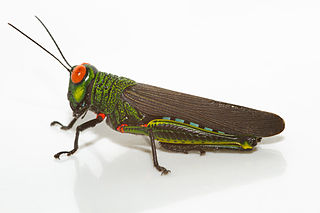
The Romaleidae or lubber grasshoppers are a family of grasshoppers, based on the type genus Romalea. The species in this family can be found in the Americas.

Schistocerca is a genus of grasshoppers, commonly called bird grasshoppers, many of which swarm as locusts. The best known species is probably the desert locust and trans-Atlantic flight may explain the biogeography of some locust species.

Endomychidae, or handsome fungus beetles, is a family of beetles with representatives found in all biogeographic realms. There are around 120 genera and 1300 species. The family was established based on the type genus Endomychus, a genus erected in 1795 by Panzer which was applied to a species that Linnaeus called Chrysomela coccinea. As the common name suggests, Endomychidae feed on fungi. Crowson, in his influential treatment of the beetles, placed the family within the Cucujoidea. They have a tarsal formal of 4-4-4 or 3-3-3 and the wings lack a closed radial cell. The second antennal segment has a sensory appendage that is as long as the third antennal segment. The family has also been grouped with the Coccinellidae in a group called the Trimera for having pseudotrimerous tarsi. A 2015 molecular phylogeny study found that the Cucujoidea were found to be non-monophyletic and the Endomychidae was refined with the removal of the Anamorphinae from within the family and elevated to the status of a full family, Anamorphidae. Mycetaeinae and Eupsilobiinae were also found not to belong within the clades of the core Endomychidae, and likewise reclassified into the families Mycetaeidae and Eupsilobiidae.

Pyrgomorphidae is a family of grasshoppers in the order Orthoptera; it is the only family in the superfamily Pyrgomorphoidea. Pyrgomorphidae is found worldwide in tropical and warm temperate regions, but the vast majority of the family's approximately 500 species are from Africa, Asia and Australia. Their name is probably derived from pyrgos meaning "tower": a reference to the form (morph) of the head in the type genus Pyrgomorpha and other genera.

Acrida is a genus of grasshoppers in the family Acrididae. The genus contains around 40 species which are found in Africa, Europe, Asia, North America, Hawaii, and Australia. Insects of this genus are omnivorous and a well-known pest of many agricultural crops.

Phymateus is a genus of fairly large grasshoppers of the family Pyrgomorphidae, native to shrubland, semi-deserts, savanna, woodland, gardens and cultivated areas in Sub-Saharan Africa, with ten species in the African mainland and two species in Madagascar. Some species have bright aposematic colours and are highly toxic.

Zanna is a genus of tropical planthoppers found in Asia and Africa, now belonging to the monotypic subfamily Zanninae.

Arphia is a genus of band-winged grasshoppers in the family Acrididae. There are at least 11 described species in the genus Arphia.
Bystus is a genus of beetles in the family Anamorphidae. There are about six described species in Bystus.

Copiocerinae is a subfamily of short-horned grasshoppers in the family Acrididae. There are at least 20 genera in Copiocerinae, found in southern North America, Central America, and South America.

Stenotarsus is a genus of handsome fungus beetles in the family Endomychidae. There are more than 50 described species in Stenotarsus.

Podoscirtinae is a subfamily of crickets in the family Gryllidae.

Proctolabinae is a subfamily of grasshoppers in the family Acrididae. There are more than 20 genera and 210 described species which are found in South America.

Chromacris is a genus of lubber grasshoppers in the family Romaleidae. The nine described species in Chromacris are found in Mexico, Central America, or South America. They often have bright aposematic colors and they are presumed to be toxic.

Tetrataenia is a genus of spur-throat toothpick grasshoppers in the family Acrididae. There are at least two described species in Tetrataenia, found in South America.

Coscineuta coxalis is a species of short-horned grasshopper in the family Acrididae. It is found in the Neotropics.

Xiphiola is a genus of short-horned grasshoppers in the family Acrididae. There are at least two described species in Xiphiola, found in South America.

Cirphula is a genus of short-horned grasshoppers in the family Acrididae. There are at least four described species in Cirphula, found in Australia.

Leptysma is a genus of spur-throat toothpick grasshoppers in the family Acrididae. There are about five described species in Leptysma.

The Ommatolampidinae are a subfamily of grasshoppers in the family Acrididae, found in central and South America, and based on the type genus Ommatolampis. Derived from the "Ommatolampides" used by Brunner von Wattenwyl in 1893, the first use of the name in its current form was by Rodríguez et al. in 2013; this taxon appears to be paraphyletic.




















